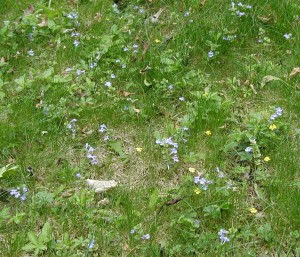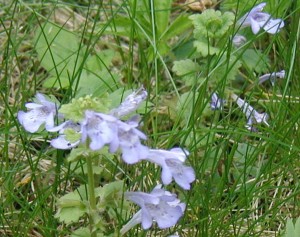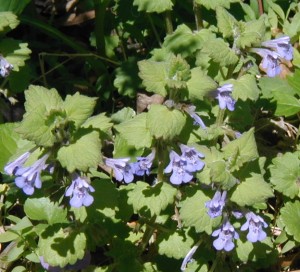Spring color arrives in many places, even the yard. We don’t care too much about keeping just grass in the lawn or yard. We even let weeds come to their flowering if we feel like mowing around them. Sure, that will only bring more weeds the next year, but who’s really gonna stop them without chemicals? Hey, our drinking water is down there!
I enjoy seeing the Common Cinquefoil, Potentilla simplex, happily dotting the grass with bright yellow smiley faces. In some places the yellow flowers are joined by the light blue blossoms of Ground Ivy, Glechoma hederacea.
Ground Ivy is also known as Gill-over-the-Ground, which sounds totally Irish, doesn’t it? Perhaps the name suggests where it originally came from as this member of the Mint Family, Lamiaceae, is alien to North America.
Leaves were once used to ferment and flavor beer, as noted in the Audubon North American Field Guide to Wildflowers. Indeed, the name Gill is traced to the French word for ferment, guiller. So, we can deduce that Gill-over-the-ground is an European introduction.
Gill-over-the-Ground is a perennial, scentless mint that trails along the ground, rooting at the leaf nodes in ivy-like fashion.

Blue flowers of ground ivy and yellow flowers of common cinquefoil don’t hide too well among the grass in the lawn.
Ground ivy flowers are irregular in shape with petals fused to make an upper lip, two side petals and a lower lip. The upper lip has two rounded lobes, the side petals flare out to the sides, and the lower lip is broad with three lobes. The inside of the flowers are spotted with dark blue while the rest of the flower is light blue.

Photos above taken 6 May 2010.
Round leaves grow opposite one another with scalloped edges, or bluntly rounded teeth. Stems creep along the ground, just like the name “ivy” foretells. Ground ivy prefers shady, moist areas.

The image above shows Ground-Ivy flowering along a trail on 30 April 2010 at Little Buffalo State Park. Note how the flowers seem to peek out from under the leaves.
Although I haven’t yet tried it, Peterson’s Edible Plant Guide tells us that ground ivy makes a pleasant herbal tea.
![Reblog this post [with Zemanta]](http://img.zemanta.com/reblog_e.png?x-id=8da3ba46-8017-4283-9d3f-287c7b2c80b3)